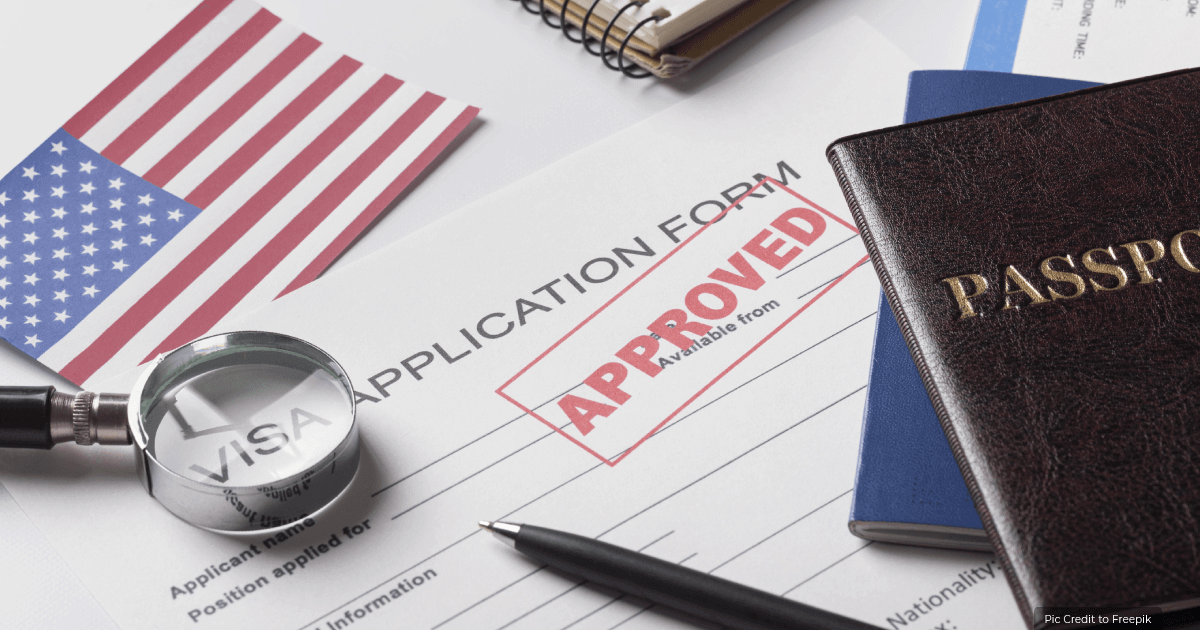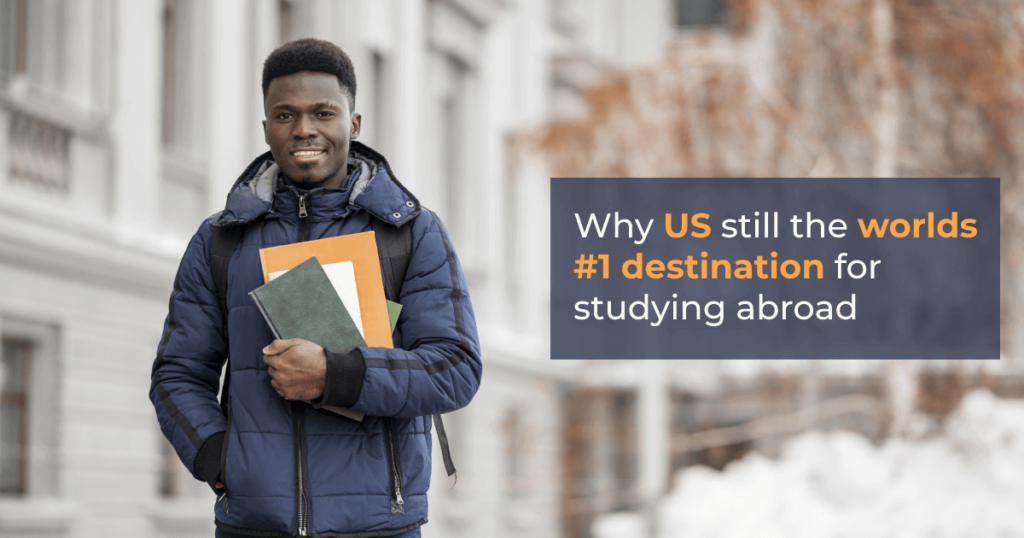Process for US Student Visa in 2024 – Embarking on an educational journey in the United States is a dream for many international students. As per the Non-Immigrant Visa Statistics, 2022, the Visa Rejection rate is 15.77 % and out of that student visa acceptance rate for Indian students has been 95% which has remained the highest in past years. A great number of educational institutions offer high quality education to students who are coming to study abroad. However, it is necessary to get your student visa so that you can get entry into the US and get admission to your dream university.
Many universities offer high-quality education in the US and give you wings to explore, making the US one of the most sought-after destinations for higher education. Here is the article we are going to share important steps for you to have an overview of your student visa application and choosing the type of student visa, along with the eligibility criteria. So that we can smoothen the process for you.

Types of Student Visas
In the United States, you can get different types of student visas, and each one of them serves a different purpose as per the educational and program needs of the student.
If you understand the types of visas in detail, you can easily select the visa that aligns with your requirements.
F-1 Visa
This is the most common type of student visa, designed for those who wish to pursue academic studies at an accredited educational institution in the US. It is suitable for students attending a full-time degree or academic program at a college, university, high school, private elementary school, seminary, conservatory, or any other academic institution or language training program.
M-1 Visa
The M-1 visa is intended for international students enrolled in vocational or non-academic programs other than language training. This includes mechanical studies, technical studies, cooking classes, and flight school.
J-1 Visa
This visa is for individuals approved to participate in work-and-study-based exchange visitor programs. This Visa is best for people who are in cultural exchange programs, academic programs and fellowships.
Choosing the Right Visa Type
Assessing your educational goals, program type, and the nature of your studies is crucial in determining the appropriate visa type.
Eligibility Criteria for US Student Visa
Before starting your visa application process, look at the eligibility criteria for obtaining a student visa. You must get all the documents in hand, and if you fail to meet any of the requirements, you might face visa denial, which can delay your educational plans.
Acceptance at a SEVP-approved School
To apply for a student visa, you must first be accepted by a school approved by the Student and Exchange Visitor Program (SEVP). Once accepted, you will receive Form I-20 or DS-2019, which is required for the visa application process.
Sufficient Financial Support
You must provide proof of having sufficient funds to cover your tuition, living expenses, and other costs for the entire duration of your stay in the US. This can include bank statements, financial guarantee letters, or scholarship awards.
Proficiency in English
Demonstrating proficiency in English is crucial, as it is the medium of instruction in US institutions. Acceptable proofs include TOEFL, IELTS, or other recognized English language proficiency test scores.
Intent to Depart the US upon Completion of Studies
In your visa application interview, you must be persuasive enough that you have ties with your home country and intend to return there once you have completed your course.
Application Process Overview
Embarking on the student visa application journey necessitates a clear understanding of the overall process. A well-informed approach can significantly alleviate the complexities involved, ensuring a smoother progression through each step.
Timeline
Initiating the application process at the right time is crucial, especially for fall intake, which typically has a higher volume of applicants. Starting early allows ample time for each step, from securing admission to attending the visa interview.
Key Steps Involved
The application process involves several key steps, including securing admission, paying the SEVIS fee, completing the DS-160 form, scheduling and attending the visa interview, and awaiting a decision. Familiarising oneself with these steps can aid in efficient navigation through the application process.
Application Timeline for Fall Intake in US 2024
If you are planning to apply for a student visa in the fall intake in US 2024, then you can follow the below steps for guidance.
When to Start (Dec 2023 – Feb 2024)
Ideally, prospective students for fall intake in US 2024 should begin the application process around 12 to 9 months before the intended start date of the program, allowing sufficient time for each step.
Admission Process (Jan 2024 – May 2024)
Securing admission and receiving the I-20 or DS-2019 form should ideally be completed 6 to 9 months before the program start date of fall intake in US 2024.
Visa Application (March 2024 – June 2024)
Completing the DS-160 form and scheduling the visa interview should be done approximately 3 to 5 months before the intended travel date to the US.
Visa Interview (April 2024 – June 2024)
Attending the visa interview should ideally be scheduled 3 months before the program start date to account for any unforeseen delays. You must know the course details and why you are doing it for fall intake in US 2024.
Post-Approval (August 2024 – September 2024)
Once the visa is approved, students can start preparing for travel and should plan to arrive in the US a few weeks before the program’s commencement.
Arrival in the US (September 2024)
It is recommended to arrive in the US at least 2 to 3 weeks before the start of the program to settle in and complete any remaining formalities.
Step by Step Process for Applying US Student Visa
Navigating through the student visa application process requires meticulous attention to each step involved. A systematic approach can significantly enhance the chances of a successful application.
Securing Admission and Receiving Form I-20 or DS-2019
The first step is to secure admission to a SEVP-approved school and receive Form I-20 or DS-2019, which is essential for the subsequent steps in the visa application process.
Paying the SEVIS Fee
After receiving the form, applicants must pay the SEVIS I-901 fee, which funds the Student and Exchange Visitor Information System (SEVIS). A confirmation receipt of the payment is required for the visa interview.
Completing the DS-160 Form
Applicants must then complete the Online Nonimmigrant Visa Application, Form DS-160, and print the confirmation page to bring to the visa interview.
Scheduling a Visa Interview
After completing the DS-160 form, applicants need to schedule a visa interview at the US Embassy or Consulate in their home country.
Preparing Necessary Documentation
Before the interview, applicants should gather all required documents, including the passport, Form I-20 or DS-2019, DS-160 confirmation page, visa appointment confirmation, SEVIS fee receipt, financial proof, academic transcripts, and test scores.
Attending the Visa Interview
Applicants must attend the scheduled visa interview, during which a consular officer will determine their eligibility for a student visa.
Awaiting a Decision
After the interview, applicants must wait for a decision on their visa application, which may involve additional administrative processing.
Following this step-by-step guide meticulously can aid in avoiding common pitfalls and ensuring a smoother and more efficient visa application process.
Required Documentation
Proper documentation is the backbone of the student visa application process. Having all the necessary documents organised and ready is crucial for a successful application and a smooth visa interview experience.
Passport
A valid passport is required, with an expiry date of at least six months beyond your period of stay in the United States.
Form I-20 or DS-2019
Issued by the SEVP-approved school, this form is crucial for applying for a student visa and must be presented at the visa interview.
DS-160 Confirmation Page
The confirmation page of the completed Online Nonimmigrant Visa Application, Form DS-160, is required at the visa interview.
Visa Appointment Confirmation
The scheduled visa interview appointment confirmation must be presented at the US Embassy or Consulate.
SEVIS Fee Receipt
Proof of payment of the SEVIS I-901 fee is mandatory during the visa interview.
Financial Proof
Documents proving sufficient funds to cover tuition, living expenses, and other costs for the entire duration of the stay in the US, such as bank statements or financial guarantee letters, are essential.
Academic Transcripts and Test Scores
Academic records, diplomas, transcripts, standardised test scores relevant to your intended field of study, and any other documents that prove your academic eligibility are required.
Additional Documents
Any other documents that may strengthen the application, such as letters of intent, essays, or recommendation letters, should also be prepared.
Preparing for the Visa Interview
The visa interview is the most important process to get your Visa approved because the consular officer will ask you questions about your background and reason for going abroad. Therefore, you must not take it lightly and prepare for it really well.
Common Interview Questions
Familiarising yourself with common questions asked during the visa interview can help in formulating clear and concise responses. Questions often revolve around your choice of institution, course, intentions post-study, and financial arrangements.
Demonstrating Ties to Home Country
It is crucial to convincingly demonstrate your intention to return to your home country after completing your studies through strong ties like family, property, or prospective employment.
Making a Positive Impression
You can make a good impression by being punctual, dressing well, smiling, and being confident. This way, you can answer questions and create a good impression in front of the officer.
Post-Approval Steps
Once the student visa is approved, there are several subsequent steps to be undertaken to ensure compliance with US immigration laws and to prepare for your journey and stay in the US.
Paying the Visa Issuance Fee
Some applicants may be required to pay a visa issuance fee after their application is approved, depending on their nationality.
Receiving the Visa
After approval and payment of the issuance fee, if applicable, applicants will receive their visa, which will be attached to their passport.
Preparing for Travel and Arrival in the US
Once the visa is received, students can start making travel arrangements, ensuring they have all necessary documents and accommodations and are aware of the US customs and immigration procedures.
Complying with US Immigration Laws
After arrival, maintaining legal status by adhering to visa terms, such as not working without authorisation and reporting address changes, is crucial to avoid any legal complications.
Following the post-approval steps meticulously is crucial for a smooth transition to life in the US and to avoid any complications during your stay.
Options after a Visa Denial
Reapplication: Applicants can reapply for a visa after addressing the reasons for denial.
Appeals: In some cases, applicants may have the option to appeal the denial decision.
Seeking Counsel: Consulting with an immigration advisor or legal counsel can provide insights into the best course of action post-denial.
Starting the Application Process Early
Early initiation allows ample time to address any unforeseen issues and reduces the stress of last-minute preparations.
Ensuring All Documents are Accurate and Complete
Any inaccuracies or missing documents can lead to delays or denials, so meticulous review an d completion of all documents are crucial.
Seeking Advice
Leveraging the expertise of the university’s international student office or a visa consultant can provide valuable insights and guidance throughout the application process.
Conclusion
You can only start your journey to study abroad after getting your student visa. While the process may seem daunting, adherence to guidelines, early preparation, and informed decision-making can significantly smoothen the path to achieving your educational aspirations in the US. Whether you are aiming for academic excellence or seeking diverse cultural experiences, securing a student visa is your gateway to a world of opportunities in the United States.





